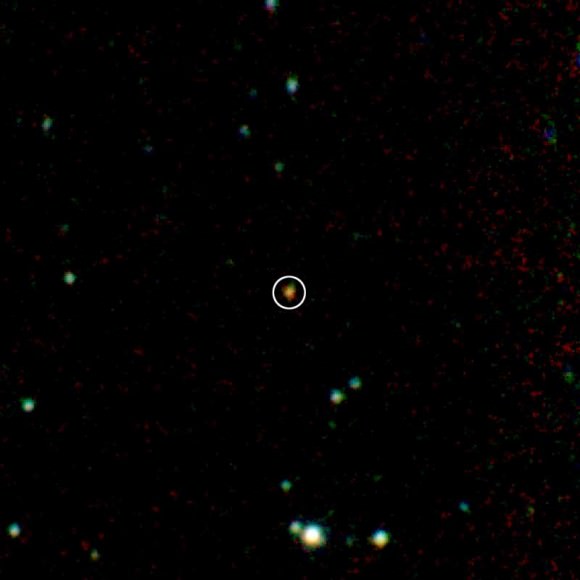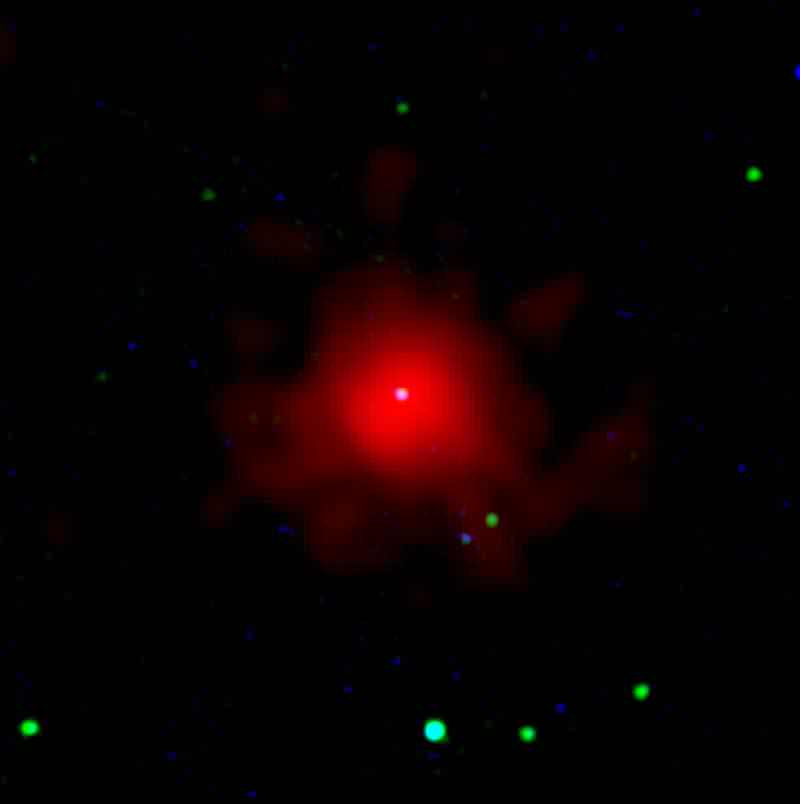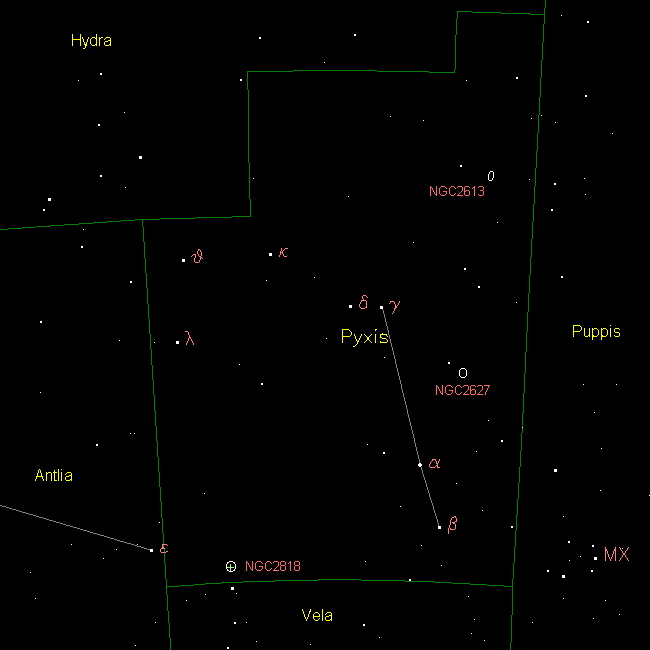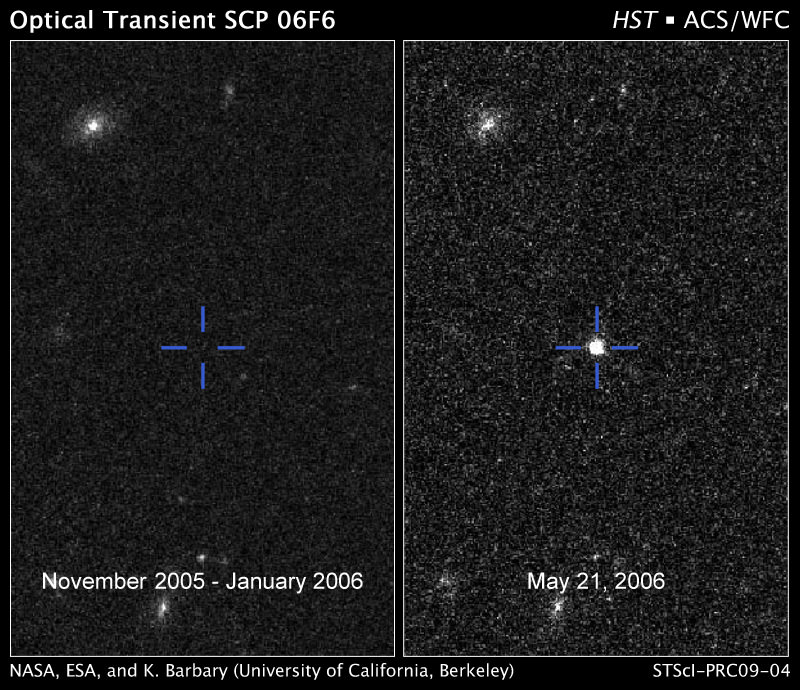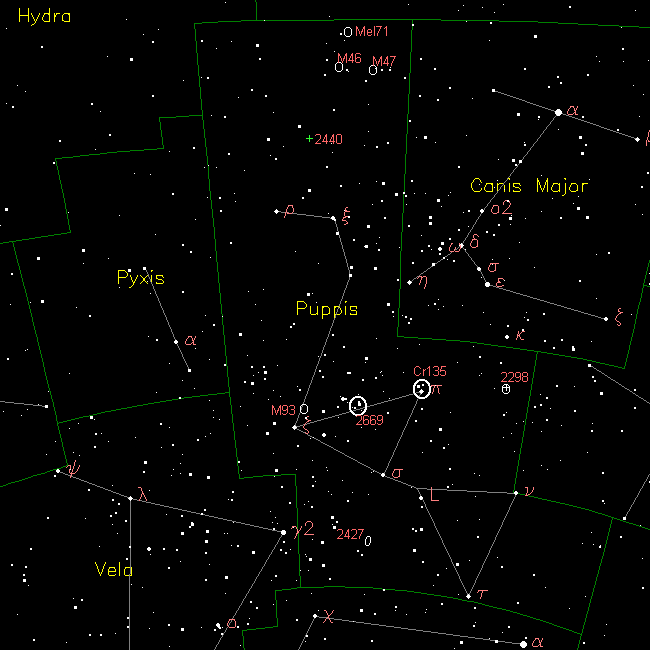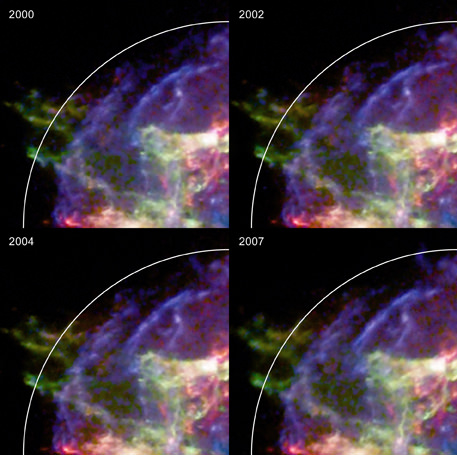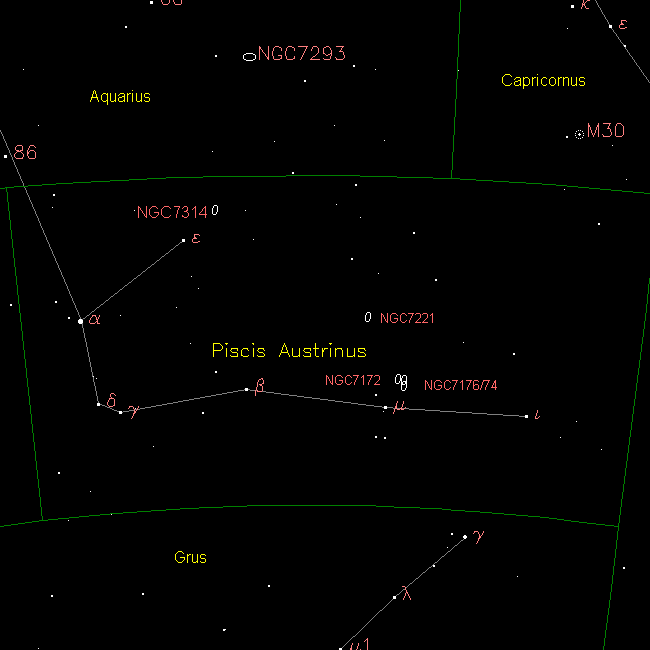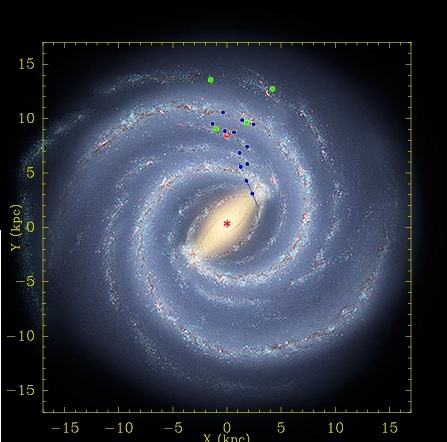[/caption]
The constellation of Puppis once belonged to a much larger constellation known as Argo Navis – the mythological ship used by Jason and the Argonauts. Argo Navis was recognized as one of the original 48 constellations charted by Ptolemy, but was later subdivided in 1752 by Nicolas Louis de Lacaille into three sections and renamed into Carina (the keel of the ship), Puppis (the poop deck), and Vela (the sails). Because Bayer Flamsteed designations were already in use at the time, the designations were also split, with each constellation taking the Argo Navis designation with it – such as Alpha and Beta belonging to Carina – while Vela has Gamma and Delta. After officially being listed as one of the 88 modern constellation by the International Astronomical Union, Puppis now occupies 673 square degrees of sky and ranks 20th in constellation size from its position just south of the ecliptic plane. Puppis is bordered by the constellations of Monoceros, Pyxis, Vela, Carina, Pictor, Columba, Canis Major and Hydra It contains 76 Bayer Flamsteed stars within its confines and its primary asterism is composed of 9 main stars. Puppis is visible to all observers located at latitudes between +40° and ?90° and is best seen at culmination during the month of February.
There are three minor annual meteor showers associated with the constellation of Puppis. Beginning each year on about April 15 through April 28, you can watch for activity from the Pi Puppids, with the peak date of maximum activity on or about April 23. The meteoroid stream is very irregular and the fall rate is variable. The Zeta Puppids begin activity around November 2 and end around December 20th with a peak date of on or about November 13th. This is also a very weak meteoroid stream which produces no more than about 3 meteors per hour at maximum. The Puppid-Velid meteor shower begins around December 2 and lasts through December 16th with a peak date on or about December 12. While this is also an understudied meteor shower, it does have a slightly more productive rate at a maximum of 4 meteors per hour during peak activity. The radiant for this shower is very complex, so keep an eye out in the whole general area. It contains several substreams and may have several different times of maxima.
As a section of the great ship Argo Navis, the mythology of Puppis is the legend of the great sea and the adventures of Jason and the Argonauts. The great galley was built under the orders of the goddess Athene, where she then fitted a beam into the prow from the oracle of Zeus. On board was a crew of Greek heros, including such notable mythological figures such as Hercules, Castor and Pollux. Of course, their journeys were legendary, and after having acquired the golden fleece they dedicated the ship to the sea god Poseidon, who immortalized it in the stars and the first of the ocean-going vessels. Due to it’s enormous size, early cartographers often had difficulty portraying it on star charts and its magical prow had disappeared. The mariner’s compass, the constellation of Pyxis, was also once considered a part of Argo Navis, too… But has also been divided away with time. As for Puppis the Poop Deck? Actually, being on the roof of the stern cabin is a mighty fine place to be if you’re sailing amongst the stars….
Let’s begin our binocular tour of Puppis with a look at the bright star right in the middle – Zeta. Named Naos, which means “ship”, this grand spectral class is O5Ia star is one of the hottest known that is visible to the unaided eye. Punching in with a surface temperature of 42,400 K, what you are looking at is an extreme blue supergiant star – one of the brightest stars in the Milky Way Galaxy! At a distance of about 1400 light years from Earth, it doesn’t appear to be that impressive, but if it were as close as Sirius, it would light up our nights bright enough to cause shadows! Putting of 21,000 times more visible light and 790,000 times more light across the spectrum than our own Sun, this incredible star would absolutely vaporize our Earth if it were anywhere near our solar system. In several hundred thousand years, Naos will begin to cool and eventually become a red supergiant star. When it ends its life in a couple of million years, chances are it will go hypernova – forming a black hole and eventually a new nebula for starbirth in the never-ending cycle of cosmic wonder. What causes it to be so unusual? There’s evidence that Noas is a “runaway star”… once formed in the Vela region and now 400 light years away from the womb.
Now, let’s begin in the north with binoculars for a look at open cluster Melotte 71 (RA 07:37:30 Dec -12:03:06). This outer disc cluster is also known as Tombaugh 2 and will show as a compression of stars in binoculars and reveal about 80 or so members to mid-sized telescopes at low magnification. It is fairly rich and contains several reddish stars.
Keep your binoculars handy, or stick with the scope for Messier 46 (RA 07: 41.8 Dec ?14:49). This grand galactic star cluster was discovered by Charles Messier in 1771. Located about 5500 light years away from Earth, you’ll find about 150 stars spread over a 30 light year wide area… But one will stand out from the rest. Good reason – it’s a planetary nebula! Planetary nebula NGC 2438 will appear at the cluster’s northern edge and is probably just in the line of sight since it does not share the same velocity as M46.
Do you see other open cluster nearby? That’s Messier 47 (RA 07:36.6 Dec -14:30). It was discovered by Giovanni Batista Hodierna before 1654 and independently discovered by Charles Messier on February 19, 1771 and added to the Messier Catalog. While it contains only about 50 or so stars, it’s much brighter and more well resolved in smaller optics. Not bad for being 78 million years old!!
Stick to the telescope to discover NGC 2440 (RA 07:41: 54.91 Dec -18:12:29.7). This planetary nebula has a central star with an exceptionally high surface temperature of 200,000 kelvins. Studied by the Hubble Space Telescope for its strange bow shape, NGC 2440 has a complex structure with dense ridges of material swept back from the nebula’s central star.
Take your telescopes or binoculars out and look just north of Xi Puppis (RA 07 44 36 Dec -23 52 00) for a “mass concentration” of starlight known as Messier 93. Discovered in March of 1781 by Charles Messier, this bright open cluster is a rich concentration of various magnitudes which will simply explode in sprays of stellar fireworks in the eyepiece of a large telescope. Spanning 18 to 22 light-years of space and residing more than 3400 light-years away, it contains not only blue giants, but lovely golds as well. Jewels in the dark sky! As you view this open star cluster, seize the moment to remember Messier, because this is one of the last objects he discovered personally. He described it as “A cluster of small stars without nebulosity” – but did he realize the light he was viewing at the time left the cluster during the reign of Ramses III? Ah, yes…sweet time. Did Charles have a clue this cluster of stars was 100 million years old? Or realize it was forming about the time Earth’s land masses were breaking up, dinosaurs ruled, and the first mammals and birds were evolving? Although H. G. Wells “Time Machine” is a work of fiction, each time we view through a telescope we take a journey back across time itself. Enjoy the mystery!
Now, head off for NGC 2669 (RA 8 : 44.9 Dec -52 : 58). At magnitude 6, this 12 arc minute open cluster is a dazzling little gem that is on many southern sky observing lists… one that’s a study for proper motions! More? Then try Collinder 135. It is also a bright and dazzling open cluster that contains Pi Puppis and may have once been part of an OB cluster. Pick Pi out of the group… with a mass of between 13 and 14 solar masses, it will most likely explode in it’s future taking its binary star companion with it! Oddly enough, Collinder 135 wasn’t even recognized as an open star cluster until the Hipparchos satellite revealed that all the stars there were at a similar distance!
Are you ready for a globular cluster? Then try NGC 2298 (RA 6 : 49.0 Dec -36 : 00). At around magnitude 9 and 7 arc minutes in size this one will be a challenge for smaller optics. NGC 2298 was discovered by James Dunlop on May 30, 1826 and cataloged as Dunlop 578. It contains a lot of variable stars and it is on its way to disruption. According to Hubble Space Telescope studies, it’s losing mass.
For the big telescope, try your luck with NGC 2427 (RA 7 : 36.5 Dec -47 : 38). At around 11th magnitude and about 7 arc minutes in size, this super low surface brightness spiral galaxy won’t take to any kind of magnification, so use a low power eyepiece. Studies have shown it displays peculiar velocities in it’s HII regions and may display gravitation instability.
Don’t forget, Puppis is located right in the Milky Way, so there’s plenty more deep sky objects to go! Get yourself a good star map and explore…
Sources:
SEDS
Wikipedia
Chart courtesy of Your Sky.
